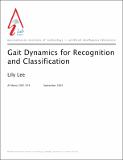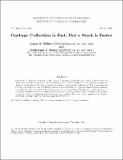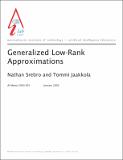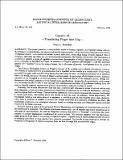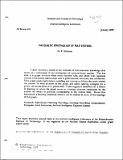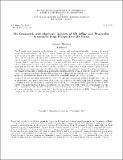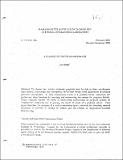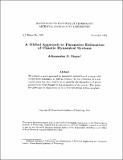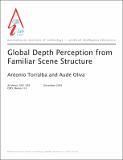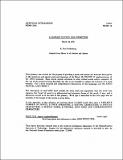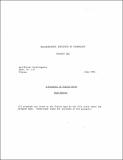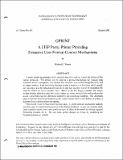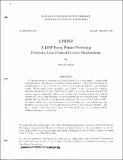Browsing AI Memos (1959 - 2004) by Title
Now showing items 410-429 of 1217
-
Gait Dynamics for Recognition and Classification
(2001-09-01)This paper describes a representation of the dynamics of human walking action for the purpose of person identification and classification by gait appearance. Our gait representation is based on simple features such as ... -
Garbage Collection is Fast, But a Stack is Faster
(1994-03-01)Prompted by claims that garbage collection can outperform stack allocation when sufficient physical memory is available, we present a careful analysis and set of cross-architecture measurements comparing these two approaches ... -
General Purpose Parallel Computation on a DNA Substrate
(1996-12-01)In this paper I describe and extend a new DNA computing paradigm introduced in Blumberg for building massively parallel machines in the DNA-computing models described by Adelman, Cai et. al., and Liu et. al. Employing ... -
Generalization over contrast and mirror reversal, but not figure-ground reversal, in an "edge-based
(2001-12-10)Baylis & Driver (Nature Neuroscience, 2001) have recently presented data on the response of neurons in macaque inferotemporal cortex (IT) to various stimulus transformations. They report that neurons can generalize over ... -
Generalized Low-Rank Approximations
(2003-01-15)We study the frequent problem of approximating a target matrix with a matrix of lower rank. We provide a simple and efficient (EM) algorithm for solving {\\em weighted} low rank approximation problems, which, unlike simple ... -
A Generalized Ordering Constraint for Stereo Correspondence
(1984-05-01)The ordering constraint along epipolar lines is a powerful constraint that has been exploited by some recent stereomatching algorithms. We formulate a generalized ordering constraint, not restricted to epipolar lines. ... -
Generating and Generalizing Models of Visual Objects
(1985-07-01)We report on initial experiments with an implemented learning system whose inputs are images of two-dimensional shapes. The system first builds semantic network descriptions of shapes based on Brady's smoothed local ... -
Genetic AI: Translating Piaget into Lisp
(1986-02-01)This paper presents a constuctivist model of human cognitive development during infancy. According to constructivism, the elements of mental representation -- even such basic elements as the concept of physical object ... -
The Genetic Epistemology of Rule Systems
(1978-01-01)I shall describe a model of the evolution of the rule-structured knowledge that serves as a cornerstone of our development of computer-based coaches. The key idea is a graph structure whose nodes represent rules, and ... -
Geometric and Algebraic Aspects of 3D Affine and Projective Structures from Perspective 2D Views
(1993-07-01)We investigate the differences --- conceptually and algorithmically --- between affine and projective frameworks for the tasks of visual recognition and reconstruction from perspective views. It is shown that an affine ... -
Geometric Structure of the Adaptive Controller of the Human Arm
(1993-07-01)The objects with which the hand interacts with may significantly change the dynamics of the arm. How does the brain adapt control of arm movements to this new dynamic? We show that adaptation is via composition of a ... -
A Glimpse of Truth Maintenance
(1978-02-01)Many procedurally-oriented problem solving systems can be viewed as performing a mixture of computation and deduction, with much of the computation serving to decide what deductions should be made. This results in ... -
A Glimpse of Truth Maintenance
(1978-11-01)To choose their actions, reasoning programs must be able to draw conclusions from limited information and subsequently revise their beliefs when discoveries invalidate previous assumptions. A truth maintenance system ... -
A Global Approach to Parameter Estimation of Chaotic Dynamical Systems
(1992-12-01)We present a novel approach to parameter estimation of systems with complicated dynamics, as well as evidence for the existence of a universal power law that enables us to quantify the dependence of global geometry ... -
Global Depth Perception from Familiar Scene Structure
(2001-12-01)In the absence of cues for absolute depth measurements as binocular disparity, motion, or defocus, the absolute distance between the observer and a scene cannot be measured. The interpretation of shading, edges and junctions ... -
A Glossary of LOGO Primitives
(1974-12-01)This is a brief description of the primitives in PDP 11 LOGO. It is intended to provide a quick reference for users who are already familiar with LOGO basics. For a more detailed and comprehensive description of LOGO, ... -
A Glossary of PDP11 LOGO Primitives
(1975-03-01)This glossary was written for the purpose of providing a quick and concise yet accurate description of the primitives and special words and characters of the March 18, 1975 PDP 11 implementation of the LOGO languge. ... -
-
GPRINT - A LISP Pretty Printer Providing Extensive User Format-Control Mechanism
(1981-10-01)A pretty printer is presented which makes it easy for a user to control the format of the output produced. The printer can be used as a general mechanism for printing data structures as well as programs. It is divided ... -
GPRINT: A LISP Pretty Printer Providing Extensive User Format Control Mechanism
(1982-09-01)A Lisp pretty printer is presented which makes it easy for a user to control the format of the output produced. The printer can be used as a general mechanism for printing data structures as well as programs. It is ...
